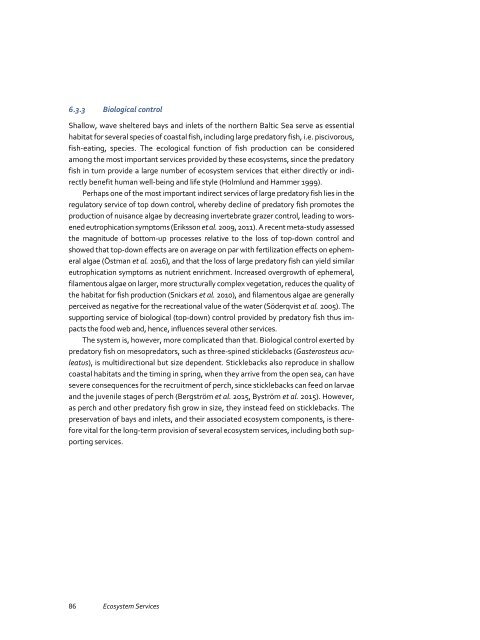Ecosystem Services
FULLTEXT01
FULLTEXT01
You also want an ePaper? Increase the reach of your titles
YUMPU automatically turns print PDFs into web optimized ePapers that Google loves.
6.3.3 Biological control<br />
Shallow, wave sheltered bays and inlets of the northern Baltic Sea serve as essential<br />
habitat for several species of coastal fish, including large predatory fish, i.e. piscivorous,<br />
fish-eating, species. The ecological function of fish production can be considered<br />
among the most important services provided by these ecosystems, since the predatory<br />
fish in turn provide a large number of ecosystem services that either directly or indirectly<br />
benefit human well-being and life style (Holmlund and Hammer 1999).<br />
Perhaps one of the most important indirect services of large predatory fish lies in the<br />
regulatory service of top down control, whereby decline of predatory fish promotes the<br />
production of nuisance algae by decreasing invertebrate grazer control, leading to worsened<br />
eutrophication symptoms (Eriksson et al. 2009, 2011). A recent meta-study assessed<br />
the magnitude of bottom-up processes relative to the loss of top-down control and<br />
showed that top-down effects are on average on par with fertilization effects on ephemeral<br />
algae (Östman et al. 2016), and that the loss of large predatory fish can yield similar<br />
eutrophication symptoms as nutrient enrichment. Increased overgrowth of ephemeral,<br />
filamentous algae on larger, more structurally complex vegetation, reduces the quality of<br />
the habitat for fish production (Snickars et al. 2010), and filamentous algae are generally<br />
perceived as negative for the recreational value of the water (Söderqvist et al. 2005). The<br />
supporting service of biological (top-down) control provided by predatory fish thus impacts<br />
the food web and, hence, influences several other services.<br />
The system is, however, more complicated than that. Biological control exerted by<br />
predatory fish on mesopredators, such as three-spined sticklebacks (Gasterosteus aculeatus),<br />
is multidirectional but size dependent. Sticklebacks also reproduce in shallow<br />
coastal habitats and the timing in spring, when they arrive from the open sea, can have<br />
severe consequences for the recruitment of perch, since sticklebacks can feed on larvae<br />
and the juvenile stages of perch (Bergström et al. 2015, Byström et al. 2015). However,<br />
as perch and other predatory fish grow in size, they instead feed on sticklebacks. The<br />
preservation of bays and inlets, and their associated ecosystem components, is therefore<br />
vital for the long-term provision of several ecosystem services, including both supporting<br />
services.<br />
86 <strong>Ecosystem</strong> <strong>Services</strong>


